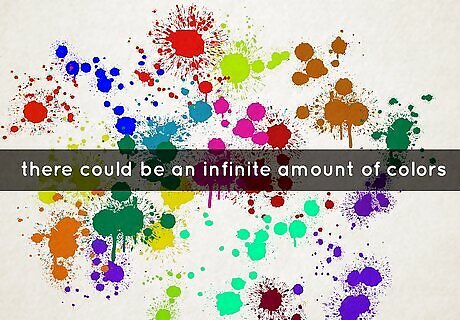
views
- Scientists estimate that there are about 10 million colors in the world.
- Everyone sees the world differently, so there may be an infinite number of colors out there we’ve yet to discover.
- You're able to see color thanks to light waves reflecting off objects.
How many colors are there in the world?

There are around 10 million colors you can see with the naked eye. How do we get this number? Well, scientists believe that we can see around 1,000 levels of light-dark, 100 levels of red-green, and 100 levels of yellow-blue. Multiply these numbers together, and you get 10,000,000 colors. However, this number is only an estimate. Everyone perceives the world differently, so who’s to say how many colors there are exactly—the answer could vary depending on who you ask! There are 7 core colors in the world: red, orange, yellow, green, blue, indigo, and violet. Every other color is simply a variation of one or more of these colors. Scientists estimate that there are around 18 decillion varieties of each color. Red-green and yellow-blue refer to primary colors and their corresponding secondary colors. If you draw or read a color wheel, red is across from green and yellow is across from blue.
Are there infinite colors?

The number of colors is an estimate, so there could be an infinite amount. “Infinite” is something without limits, endless, or an extremely great amount. When it comes to colors, there certainly are a great amount of them, but to say there’s not an end depends on your perspective. Believe it or not, there may be a whole world of color humans cannot see. Your brain can only comprehend the colors you know (the core colors of the rainbow and their varieties). Who’s to know if animals see an entirely different world of color than what you’re familiar with.
The Science of Color

Reflected light waves help you see color. Believe it or not, that blue pen you’re looking at isn’t actually blue—it’s every color but blue! When light hits an object, light waves bounce off of it. The color that reflects into your eye is the color it appears to be. There’s a tissue in the back of your eye called the retina. It’s this tissue’s job to spot light and let the brain know what it’s seeing. When light hits your retina, the tissue sends an electric signal to your optic nerve. The optic nerve’s signal travels through your brain’s thalamus (think of this like a post office), which then ships the signal to your visual cortex. It’s in the visual cortex where your brain starts piecing together the color, so you know exactly what you’re seeing. This may sound like a lengthy and time-consuming process, but it happens as quickly as it takes for you to look at something.




















Comments
0 comment